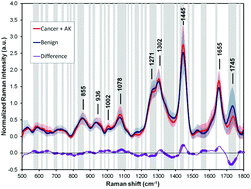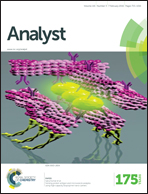Wavenumber selection based analysis in Raman spectroscopy improves skin cancer diagnostic specificity†
Abstract
Real-time Raman spectroscopy can be used to assist in assessing skin lesions suspicious for cancer. Most of the diagnostic algorithms are based on full band of the Raman spectra, either in the fingerprint region or the high wavenumber region. In this paper we explored wavenumber selection based analysis in Raman spectroscopy for skin cancer diagnosis. Wavenumber selection was implemented using windows of wavenumber and leave-one-out cross-validated stepwise regression or least and shrinkage selection operator (LASSO). The diagnostic algorithms were then generated from the selected windows of wavenumber using multivariate statistical analyses, including principal component and general discriminate analysis (PC-GDA) and partial least squares (PLS). In total a combined cohort of 645 confirmed lesions from 573 patients encompassing skin cancers, precancers and benign skin lesions were included, which were divided into training cohort (n = 518) and testing cohort (n = 127) according to the measurement time. It was found that the area under the receiver operating characteristic curve (ROC) was improved from 0.861–0.891 to 0.891–0.911 and the diagnostic specificity for fixed sensitivity 0.99–0.90 was improved from 0.17–0.65 to 0.20–0.75 with wavenumber selection based analysis.

- This article is part of the themed collection: Innovative Tools for Cancer Screening, Detection and Diagnostics

 Please wait while we load your content...
Please wait while we load your content...